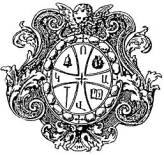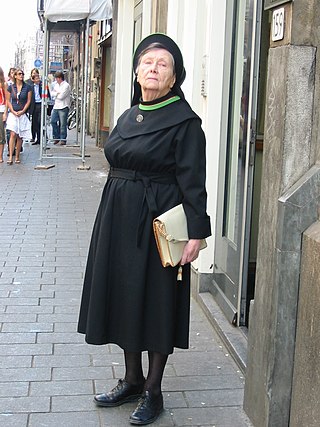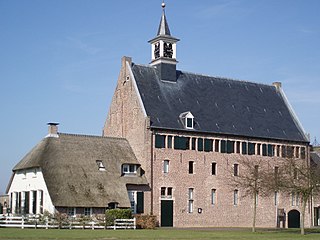
The Benedictines, officially the Order of Saint Benedict, are a mainly contemplative monastic order of the Catholic Church for men and for women who follow the Rule of Saint Benedict. Initiated in 529 they are the oldest of all the religious orders in the Latin Church. The male religious are also sometimes called the Black Monks, especially in English speaking countries, after the colour of their habits. Not all Benedictines wear black however, with some like the Olivetans wearing white. They were founded by Benedict of Nursia, a 6th-century Italian monk who laid the foundations of Benedictine monasticism through the formulation of his Rule. Benedict's sister, Scholastica, possibly his twin, also became a religious from an early age, but chose to live as a hermit. They retained a close relationship until her death.

Augustinians are members of several religious orders that follow the Rule of Saint Augustine, written in about 400 AD by Augustine of Hippo. There are two distinct types of Augustinians in Catholic religious orders dating back to the 12th–13th centuries:

Christian monasticism is a religious way of life of Christians who live ascetic and typically cloistered lives that are dedicated to Christian worship. It began to develop early in the history of the Christian Church, modeled upon scriptural examples and ideals, including those in the Old Testament. It has come to be regulated by religious rules and, in modern times, the Canon law of the respective Christian denominations that have forms of monastic living. Those living the monastic life are known by the generic terms monks (men) and nuns (women). The word monk originated from the Greek μοναχός, itself from μόνος meaning 'alone'.

The Servite Order, officially known as the Order of Servants of Mary, is one of the five original mendicant orders in the Roman Catholic Church. It includes several branches of friars, contemplative nuns, a congregation of religious sisters, and lay groups. The order's objectives are the sanctification of its members, the preaching of the Gospel, and the propagation of devotion to the Mother of God, with special reference to her sorrows. The Servites friars lead a community life in the tradition of the mendicant orders.

Mendicant orders are, primarily, certain Roman Catholic religious orders that have adopted for their male members a lifestyle of poverty, traveling, and living in urban areas for purposes of preaching, evangelization, and ministry, especially to the poor. At their foundation these orders rejected the previously established monastic model, which prescribed living in one stable, isolated community where members worked at a trade and owned property in common, including land, buildings and other wealth. By contrast, the mendicants avoided owning property at all, did not work at a trade, and embraced a poor, often itinerant lifestyle. They depended for their survival on the goodwill of the people to whom they preached. The members of these orders are not called monks but friars.

The Rule of Saint Augustine, written in about the year 400, is a brief document divided into eight chapters and serves as an outline for religious life lived in community. It is the oldest monastic rule in the Western Church.

The Hieronymites or Jeronimites, also formally known as the Order of Saint Jerome, is a Catholic cloistered religious order and a common name for several congregations of hermit monks living according to the Rule of Saint Augustine, though the role principle of their lives is that of the 5th-century hermit and biblical scholar Jerome.

The Mechitarists, officially the Benedictine Congregation of the Mechitarists, is an Armenian Catholic monastic order of pontifical right for men founded in 1701 by Mekhitar of Sebaste. Members use the postnominal abbreviation CAM.
The Canons Regular of St. Augustine are priests who live in community under a rule and are generally organised into religious orders, differing from both secular canons and other forms of religious life, such as clerics regular, designated by a partly similar terminology. As religious communities, they have laybrothers as part of the community.
A canoness is a member of a religious community of vowed women, historically a stable community dedicated to the celebration of the Liturgy of the Hours in a particular church. The name corresponds to a canon, the male equivalent, and both roles share a common historical origin. As with the canons, there are two types: canonesses regular, who follow the Rule of St Augustine, and secular canonesses, who follow no monastic rule of life.
Clerics regular are clerics who are members of a religious order under a rule of life (regular). Clerics regular differ from canons regular in that they devote themselves more to pastoral care, in place of an obligation to the praying of the Liturgy of the Hours in common, and have fewer observances in their rule of life.

The Hospital Brothers of Saint Anthony, Order of Saint Anthony or Canons Regular of Saint Anthony of Vienne, also Antonines or Antonites, were a congregation in the Roman Catholic church, founded in c. 1095, with the purpose of caring for those suffering from the common medieval disease of Saint Anthony's fire. The mother abbey was the abbey of Saint-Antoine-l'Abbaye.
The Third Order of Saint Francis is a third order in the Franciscan tradition of Christianity, founded by the medieval Italian Catholic friar Francis of Assisi.
Paulists, or Paulines, is the name used for Roman Catholic orders and congregations under the patronage of Paul of Thebes the First Hermit. From the time that the abode and virtues of Paul of Thebes were revealed to Antony the Abbot, various communities of hermits adopted him as their patron saint.
Independent Augustinian communities are Roman Catholic religious communities that follow the Augustinian Rule, but are not under the jurisdiction of the Prior General of the Augustinian hermits in Rome.

Augustinian nuns are the most ancient and continuous segment of the Roman Catholic Augustinian religious order under the canons of contemporary historical method. The Augustinian nuns, named after Saint Augustine of Hippo, are several Roman Catholic enclosed monastic communities of women living according to a guide to religious life known as the Rule of St. Augustine. Prominent Augustinian nuns include Italian mystic St. Clare of Montefalco and St. Rita of Cascia.

The Congregation of Windesheim is a congregation of Augustinian canons regular. It takes its name from its most important monastery, which was located at Windesheim, about four miles south of Zwolle on the IJssel, in the Netherlands.
The Basilian Chouerite Order of Saint John the Baptist is a Melkite Greek Catholic monastic order of Pontifical Right for Men. The members of the Order add the nominal B.C after their names to indicate their membership in the Order.
In the Catholic Church, a religious institute is "a society in which members, according to proper law, pronounce public vows, either perpetual or temporary which are to be renewed, however, when the period of time has elapsed, and lead a life of brothers or sisters in common."
The Sisters of Saint Andrew [RSA], are a Catholic religious congregation of women whose origins dated back to the 13th Century. Founded in Tournai, Belgium, by two sisters who sold off their property and possessions in order to open a hospice for pilgrims and travellers, they received their first formal recognition by Pope Innocent IV in 1249. Obliged to become a monastic order by the conciliar changes wrought by the Council of Trent, the congregation adopted its current charism and constitutions based on Ignatian spirituality in the 19th century.









